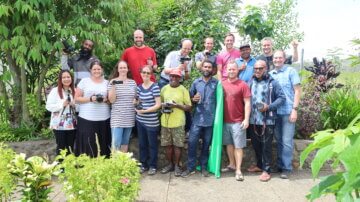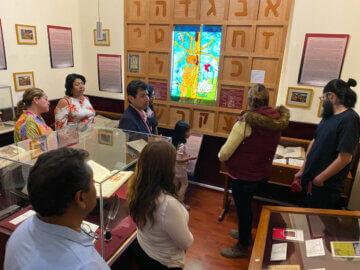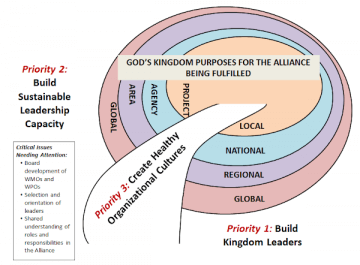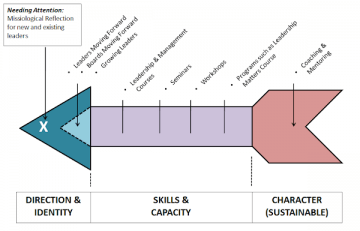Leadership Foundations: Leadership Development in the Wycliffe Global Alliance
Synopsis:
The structure of the Wycliffe Global Alliance is more like a global organization of organizations than a singular Western international body. The Alliance has distinct leadership development requirements that are unlike the majority of mission agencies, and its organizational development requirements are unique.
Beginning with the 2006 Global Leaders Meeting, leaders from Wycliffe Member Organizations and the international administration gave input about the future of Wycliffe Bible Translators International (WBTI, the precursor of the Alliance).
During a leadership survey at the Wycliffe International Convention in 2008, leaders from Wycliffe organizations and partners from 50 countries were asked to identify their leadership development needs. Following on this, at five ‘Leaders Moving Forward’ events held in 2009-2010, discussions were held with younger and newer leaders, addressing fundamentals that Wycliffe’s leadership had identified as necessary for emerging leaders.
Since 2006, much has changed based on the organizational and leadership development input given, including the growing missiological understanding of what it means to be an Alliance leader in the missio Dei. Other changes include: initiation of the organization’s Global Leadership Team in 2008; moving the operational headquarters from Dallas, Texas to an office in Singapore in 2009; a regional structure review in 2010, with special attention given to developing leadership in Africa; changing WBTI’s ‘doing business as’ name to the Wycliffe Global Alliance in 2011; and the on-going transition from being an international body to a global movement, demonstrating that Wycliffe leadership is focusing on promoting clarity of vision and building unity of commitment within the Alliance.
The Alliance operates in an environment of discontinuous change, due to the unanticipated disruptions caused by the global context in which it serves. This requires new skills for its leaders. To some degree this is being addressed by encouraging its leaders to be reflective practitioners (Article 15) who learn to reflect, understand, question and explore missional issues – all within the context of a multicultural and intercultural world.
Full Article: Article 16 – Leadership Foundations: Leadership Development in the Wycliffe Global Alliance
The structure of the Wycliffe Global Alliance is more similar to a global organization of organizations than it is to a singular Western international body. This means that the Alliance has distinct leadership development requirements that are unlike the majority of mission agencies. It also means the organizational development requirements of the Alliance are unique.
What follows is a recent organization and leadership development overview of Wycliffe Global Alliance that highlights key issues:
WBTI Global Leaders Meeting, 2006
Approximately 75 leaders attended the 2006 Global Leaders Meeting at Chiang Mai, Thailand. They came from Wycliffe Member Organizations and the international administration. In table groups, they were asked to give input about the future of Wycliffe Bible Translators International (WBTI, the precursor of the Alliance). Their responses are grouped around three questions (WBTI 2006:1-6):
Question 1: “What should be the primary role of the future WBTI Administration?” A summary of responses is: 1) experiment with ‘affinity groupings’ of organizations within WBTI around common opportunities, challenges and strategic partnerships; 2) create an ethos that gives greater attention to partnering with the global church; 3) take greater risks in organizational development to create a structure that is truly global; 4) help the organizations within WBTI develop a global mindset; and 5) provide resources for strategic initiatives rather than for maintaining an administrative infrastructure.
Question 2: “What are considerations concerning the future structure of WBTI?” Key ideas are: 1) leaders should think more radically because WBTI is moving from a monolithic structure to a movement rather than the reverse; 2) the structure needs to flow out of and be consistent with WBTI’s historical and foundational characteristics; 3) the structure should change from an organization of organizations to an alliance of organizations; 4) various organizational structures can be considered such as a decentralized structure grouped according to language/linguistic family, or around similar interests or affinities; 5) WBTI can be structured around functions (research, personnel, partnership, administration, strategy) rather than geography; and 6) whatever the structure, keep it flat and minimalistic so that the Wycliffe organizations have greater freedom to partner with each other rather than be controlled by regional leadership that might restrict collaboration within a region.
Question 3: “What are considerations about having the future WBTI headquarters outside of the US?” Responses favoured moving it to a location in Asia to demonstrate that WBTI was consciously shifting from being perceived as North American.
Leadership survey at the Wycliffe International Convention, 2008
During the WBTI quadrennial meeting at Chiang Mai, Thailand, leaders from Wycliffe organizations and partners from 50 countries were asked to identify their leadership development needs. They listed 59 individual topics that articulated their needs; these are grouped as: 1) mentoring/coaching/ ongoing training in leadership; 2) practical skill development (particularly in management areas); 3) gaining specific orientation to Wycliffe; 4) personal growth; 5) accountability to their governing Boards; 6) preparing for and managing leadership transition; and 7) learning to reflect on their contexts (Franklin 2009b:414).
This last topic (which tallied less than 7% of the total of 59 topics) refers to the reflective practitioner concept of leadership. Because of its minimal mention, this could mean that the majority of leaders identified their needs in practical areas and ongoing leadership development, or more likely that they were unfamiliar with the concept of leading as reflective practitioners.
Leaders Moving Forward events, 2009-2010
Five ‘Leaders Moving Forward’ events were held by the Alliance in San Jose, Costa Rica (2009), Bangkok, Thailand (2009), Burbach, Germany (2010), Lima, Peru (2010) and Nairobi, Kenya (2010). The purpose of each event was to help younger and newer leaders to “move forward as they lead effective and sustainable organizations that make their best contribution to Vision 2025 within their contexts” (Franklin 2009c:1).
Each event was a ‘round-table’ experience of participants and facilitators engaging in discussions for four days about fundamentals that Wycliffe’s leadership had identified as necessary for emerging leaders: 1) spiritual (prayer, worship and devotional studies about shepherd leadership; 2) theological (the missio Dei, the Kingdom of God, and the mission of the church); 3) missiological (exploring the history, importance and impact of Bible translation, and the use of power in mission); 4) leadership (examining visionary leadership and its cross-cultural implications); 5) partnering (the value of strategic partnerships in the Bible translation movement); and 6) orientation to the Alliance.
During the Lima event, 25 participants from the Andes region of Latin America gathered. Their evaluations of the event generally indicated that the ‘shepherd leadership’ model was a new one for them and quite counter-cultural, but they wanted to explore it further in their contexts. They also gained a greater understanding about what it means to be a leader in the missio Dei (LMF 2010:1-6).
At the Bangkok event, evaluations from the 30 participants from Asia-Pacific highly ranked the positive impact of these missiological topics: 1) developing missiological reflection; 2) the role of the church; 3) the use of power in mission (particularly the use of the ‘sailing boat’ metaphor); and 4) the theme of urgency related to Vision 2025 (the vision is urgent, not because of time, but because of God’s ‘passion’ for his creation) (LMF 2009:1-8).
Feedback from all of the events indicated that the topic of use (or misuse) of power in mission was a revelation to most.
Feedback from all of the events indicated that the topic of use (or misuse) of power in mission was a revelation to most. The metaphor is based upon a ‘powerboat’ compared to a ‘sailboat’ as two models of power in mission. Proponents of the powerboat model operate in a high-control, self-reliant manner that is dependent upon management methods and technology. This mindset influences most Christian ministry in some form or another, “from strategic planning and management – to evangelism and church planting – to donor relations and fund-raising” (Araujo & Mischke 2009:2).
Introducing the paradigm of the sailboat with its shared-control brought new insights into the use of power in mission. The model relies on the ‘wind of the Spirit’ who works in the affairs of God’s kingdom. This is the ‘force’ that enables and guides mission. It is external and not controlled by people, “like the wind that moves a sailboat…” (Araujo & Mischke 2009:2). Leaders from the global South and East in particular identified with the sailboat metaphor as they believed it was more appropriate to their contexts as they all had encounters (often unpleasant) with the powerboat model.
Leadership Development Roundtable, 2011
A delegation of 27 people gathered for the Alliance’s Leadership Development Roundtable in Manila, Philippines. Also in attendance were experienced leaders from Interserve International, OMF International, SIM International and OM International. The purpose of the Roundtable was to discuss leadership development needs and trends within each agency and to find ways of collaborating together.
A situational analysis was given in advance with each participant asked, “What are the most critical needs and issues our organizations are facing in developing leaders, and how are we addressing them?” The responses were: 1) re-inspiring a positive leadership vision and culture within our agencies that is vibrant and inspirational enough to attract existing and emerging leaders to serve the group and to sustain them as leaders; 2) identifying and recruiting a continuing, sufficient supply of the right kind of leaders; 3) preparing leaders from diverse cultural backgrounds to facilitate the involvement of an exponentially growing number of majority-world workers, to lead teams of such workers wisely, and to navigate the complexities of the increasingly inter-cultural organizations and the contexts where they serve; and 4) equipping leaders in specific areas with a missiological foundation for their service (LDR 2011:6-10).
The main issue: “creating a positive leadership vision and culture in our agencies… that encourages leaders to emerge, and sustains them as they serve”.
Todd Poulter, a facilitator of the Roundtable, summarized this input into the main issue that the participants identified as “creating a positive leadership vision and culture in our agencies… that encourages leaders to emerge, and sustains them as they serve” (LDR2011:2).
In exploring this issue further at the Roundtable, the participants observed that a wide range of existing leadership development concepts already exists, although most are based on individualistic, consumer-based, and mono-cultural business models. They noted that development models utilized by their mission agencies relied on the same kind of materials.
Finding a biblical foundation for leadership development that acts as a balancing influence was presented at the Roundtable. Participants arrived at five overarching principles to consider: 1) Scripture is recorded with salvation history in focus but no specific leadership ‘style’ is mandated by Scripture; 2) leadership models found in scripture are diverse and context-specific and not necessarily intended for current contexts, although they provide many lessons; 3) epochal events call for different kinds of leadership – as evident in the leadership of Joseph, Moses, Joshua, and others – such that each leader filled their role in accord with their epoch, suggesting the need to discern the times to know the style of leadership needed; 4) contexts change and so should leadership styles, so leaders must stay alert to changing contexts; and 5) specific leadership characteristics and values are found in the Bible that call leaders to demonstrate godliness (WGA 2011:3-4).
Applying the biblical principles to current contexts requires some missiological considerations: 1) being aware that current events and contexts differ from those of biblical times; 2) there are many missiological themes (e.g. globalization, contextualization, indigenization, enculturation, interculturation and partnerships) that influence leadership development; 3) knowing how mission history has impacted leaders is important; 4) recognizing the diverse range of leadership models that can be used in the global context; 5) developing leadership within the holistic transformation of communities, rather than just focussing upon the development of the leader; and 6) developing leaders takes place within the praxis of the leadership role, rather than simply providing awareness of cross-cultural and contextual issues (WGA 2011:3-4).
Another outcome of the Roundtable that was specific to the Alliance was that leadership development should take place as illustrated in diagram 1 below. For God’s kingdom purposes to be fulfilled, the attention of the Alliance should focus on three priorities: 1) building ‘kingdom leaders’ at the global level (i.e. the Alliance), regional level (i.e. Alliance Area structures), national level (i.e. the organizations within the Alliance) and local level (i.e. individual Bible translation projects or programs); 2) building sustainable leadership capacity that focuses on development of the Boards that govern each organization within the Alliance, including how to purposefully select and orientate new leaders at all levels; and 3) creating healthy organizational structures – a priority that cuts across, overlaps with and supports the other two (WGAa 2011:2).
This global perspective was fine-tuned as illustrated in diagram 2 below. Using the metaphor of an arrow, the development of a leader has three basic characteristics and each is developed by different methods: 1) the foundation of ‘character’ is the strength that makes a leader sustainable and it is formed through coaching and mentoring; 2) the foundation of ‘skills and capacity’ is developed through specific courses, workshops, and seminars (formal and non-formal) that provide new skills to increase a leader’s capacity in specific areas; and 3) the foundation of ‘identity and direction’ needs the greatest attention because it is about shaping leaders missiologically through their ability to think and act missionally. Leadership development programs that the Alliance has used, such as ‘Leaders Moving Forward’ and ‘Boards Moving Forward,’ were mentioned positively in this respect (WGAa 2011:2).
Preparing for Leadership Development Roundtable 2, 2012
In preparation for a second Roundtable, 15 leaders from Wycliffe Global Alliance were asked about the most important issues associated with developing new leaders. The following responses are summarized according to the level of the leaders:
1) Senior executive level: Their concern is helping new and current leaders to lead from a missiological foundation. They see the need to integrate holistic missiological practices that are essential and practical. They want to help new and current leaders lead from a spiritually balanced lifestyle. These issues combine together as people are identified, developed and mentored in multicultural and virtual contexts (WGAb 2012:1-4).
2) Global consultant level: Their interest is assisting leaders to integrate missiological thinking into their leadership context. They also desire leadership that is not success oriented but instead portrays humility, courage and vulnerability. They want to develop leaders in the wider context of organizational development as well as encouraging their influence to shape strategies and structures (WGAb 2012:1-4).
3) Regional leader level: They want to facilitate missiological learning communities for current and new leaders that provide an atmosphere to sharpen missiological skills principles. They want to identify core competencies for younger leaders. They also want an organisational culture where leadership development thrives (WGAb 2012:1-4).
This summary resonates with other themes discussed so far: 1) the importance of grounding leaders with a missiological foundation; 2) helping leaders in complex cross-cultural, multi-cultural and inter-cultural paradigms; 3) intentionally developing the next generation of leaders; and 4) taking a holistic view of leadership development to ensure the whole person is being nurtured.
What has changed since 2006?
Since the input from the WBTI Global Leaders Meeting of 2006, much has changed based on the organizational and leadership development input given. For example: 1) In January 2008, the Global Leadership Team of the organization was initiated with a team of 13 people working from ten locations using a flat-decentralized structure; 2) in 2009 the operational headquarters for the organization was moved from Dallas, Texas to an office in Singapore. A small core team of Singaporeans and a few expatriates work from this office; 3) a review of the regional structure was conducted in 2010 with special attention given to developing leadership in Africa. Subsequently since January 2011, Africans from East and Central Africa are in strategic leadership roles; 4) in February 2011, WBTI’s ‘doing business as’ name was changed to the Wycliffe Global Alliance, reflecting an alliance of over 110 Wycliffe Organizations; and 5) the transition from being an international body to, increasingly, a global movement means that Wycliffe leadership is focusing on promoting clarity of vision and building unity of commitment within the Alliance.
Leadership Foundations: Conclusion
Article 14 presented a lengthy overview of leadership principles, traits and types that demonstrate the complexity of the topic. It is fair to conclude that successful leaders must embrace a wide variety of qualities, skills and capabilities. Today’s leaders need to understand how to lead change by moving beyond reacting to change as it occurs. Instead they need to be “predicting and redirecting change” before it happens (Wren 1995:459).
Popular leadership theories explored in Article 14 have a Western orientation. However, as Article 15 makes clear, globalization requires leaders to be equipped to respond to greater cultural diversity. Since most leadership principles are culturally bound this creates obstacles in cross-cultural situations, but a successful multicultural organization learns to focus on both worldwide and local objectives. The global mission context requires a leadership model that places a priority on people from different cultures participating together in a community of trust.
There are several leadership types that are pertinent to mission in the global context that include: 1) the transformational leader who encourages creative ideas and intellectual stimulation; 2) the servant leader who develops trust and leads by example; 3) the shepherd leader who uses diverse skills and techniques according to the needs of the context; and 4) the missional leader who understands their part in the missio Dei. All of these types can be blended together to give dynamic mission leadership.
Outlined above are some of the Alliance’s leadership and organizational development discussions over the past six years. An obvious impact of these has been the growing missiological understanding of what it means to be an Alliance leader in the missio Dei.
The Alliance operates in an environment of discontinuous change (due to the unanticipated disruptions caused by the global context in which it serves). This requires new skills for its leaders, and to some degree this is being addressed by encouraging its leaders to be reflective practitioners (Article 15) who learn the ability to reflect, understand, question and explore missional issues – all within the context of a multicultural and intercultural world. This allows multiple perspectives because any culture‐specific model, whether Western or non‐Western, is inadequate by itself. It must be informed by other cultural perspectives, as well as the Bible.
The latest
View all articles
03/2024 Pacific: Papua New Guinea
Informing, teaching, inspiring: PNG workshop teaches video storytelling for language communities
PNG workshop teaches video storytelling for language communities
Read more
02/2024 Global
Looking ahead at 2024
As the year unfolds, we marvel at the work of God in our rapidly changing world. And, we look forward to a number of gatherings and conversations intended to draw us together.
Read more
01/2024 Americas
Telling the Bible's Story
It may come as a surprise that a museum is among the Wycliffe Global Alliance organisations.
Read more

